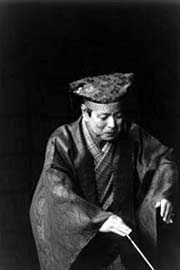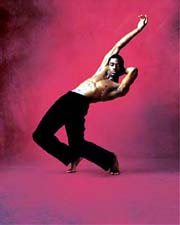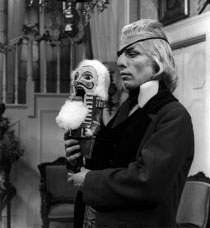Letter from New York
15
December 2003.
Copyright ©2003 by Mindy Aloff
 Mansaku
Nomura, the John Gielgud of classical Japanese theater, performed with
his son Mansai and his four or five year-old grandson Yuuki at Japan Society
this week in what, for me, was the finest example of the actor’s
art to be seen in New York since January 1982, when I last saw Nomura
at Asia House. Mansaku Nomura is a master of kyogen (“crazy word”)
drama: a six century-old, dialogue-based theater, comic in nature, that
developed contemporaneously with noh and is often performed as an interlude
between tragic or mystical noh plays. In this little season presented
by the Nomura family, the nightly programs of two 45-minute plays were
kyogen all the way—although, the night I attended, one of the two,
Kawakami (translated as Kawakami Headwaters), evoked smiles through
tears, and the other, Utsubozaru (The Monkey Skin Quiver), evoked
laughter through horror. Kawakami is about an elderly blind man
(Mansaku Nomura), who, to regain his sight, must promise to divorce his
beloved wife (played by Yukio Ishida, a former student of Mansaku’s
and now the head of his own noh/kyogen company). Utsubozaru concerns a
samurai (Mansai Nomura) who, about to go hunting, insists on wresting
a trained baby monkey from its trainer in order to skin it for its fur
to cover the quiver for his arrows. The baby monkey, played by Yuuki Nomura,
thinks that the stick being raised to brain it is actually a cue for it
to dance. The samurai, astonished at the monkey’s skill, relents
and keeps his quiver as it was.
Mansaku
Nomura, the John Gielgud of classical Japanese theater, performed with
his son Mansai and his four or five year-old grandson Yuuki at Japan Society
this week in what, for me, was the finest example of the actor’s
art to be seen in New York since January 1982, when I last saw Nomura
at Asia House. Mansaku Nomura is a master of kyogen (“crazy word”)
drama: a six century-old, dialogue-based theater, comic in nature, that
developed contemporaneously with noh and is often performed as an interlude
between tragic or mystical noh plays. In this little season presented
by the Nomura family, the nightly programs of two 45-minute plays were
kyogen all the way—although, the night I attended, one of the two,
Kawakami (translated as Kawakami Headwaters), evoked smiles through
tears, and the other, Utsubozaru (The Monkey Skin Quiver), evoked
laughter through horror. Kawakami is about an elderly blind man
(Mansaku Nomura), who, to regain his sight, must promise to divorce his
beloved wife (played by Yukio Ishida, a former student of Mansaku’s
and now the head of his own noh/kyogen company). Utsubozaru concerns a
samurai (Mansai Nomura) who, about to go hunting, insists on wresting
a trained baby monkey from its trainer in order to skin it for its fur
to cover the quiver for his arrows. The baby monkey, played by Yuuki Nomura,
thinks that the stick being raised to brain it is actually a cue for it
to dance. The samurai, astonished at the monkey’s skill, relents
and keeps his quiver as it was.
read article
Ailey's Feast of Dancing and Premieres
HeartSong/Juba/Revelations
Alvin Ailey American Dance Theater
City Center
New York, NY
December 13, 2003
By
Susan Reiter
Copyright
© 2003 by Susan Reiter
 The
premieres just keep on coming each year during the Ailey season, and certainly
choreographers must be lining up to get a chance to work with these gorgeous,
tireless, dedicated dancers. Many of the choreographers seem to cram as
many of the company's A-list dancers into their works as possible—there's
no official hierarchy, and artistic director Judith Jamison really spreads
the roles around, but certain members are clearly the unofficial soloists—as
though they've been presented with a feast and want to sample everything
available.
The
premieres just keep on coming each year during the Ailey season, and certainly
choreographers must be lining up to get a chance to work with these gorgeous,
tireless, dedicated dancers. Many of the choreographers seem to cram as
many of the company's A-list dancers into their works as possible—there's
no official hierarchy, and artistic director Judith Jamison really spreads
the roles around, but certain members are clearly the unofficial soloists—as
though they've been presented with a feast and want to sample everything
available.
The new
works tend to come and go; among the recent ones, Ronald K. Brown's are
among the few to find an ongoing place in the Ailey repertory. Too many
of the premieres are in suite form, consisting of assembled musical selections
and offering a rich display of dancing that does not cohere or add up
to much. Some tend toward the harsh and edgy; other are more showbiz and
display-oriented.
read review
A
celebration of George Balanchine:
Selected Television Work
Let’s Take a Trip and Playhouse 90: The Nutcracker
The Museum of Television & Radio
New York and Los Angeles
December 5-28
By
Dale Brauner
copyright
© 2003 by Dale Brauner
 George
Balanchine, born in the early years of the 20th century, was one of the
great forward-thinking artists. As new technology emerged, he was quick
to incorporate or use it. His works, such as Episodes and Agon,
reflected an influence of the mechanical age. In the early years of the
information age, Balanchine though originally skeptical saw the New York
City Ballet perform his works regularly on television during the 1950s
through the 1960s on the variety shows popular at the time.
George
Balanchine, born in the early years of the 20th century, was one of the
great forward-thinking artists. As new technology emerged, he was quick
to incorporate or use it. His works, such as Episodes and Agon,
reflected an influence of the mechanical age. In the early years of the
information age, Balanchine though originally skeptical saw the New York
City Ballet perform his works regularly on television during the 1950s
through the 1960s on the variety shows popular at the time.
Although invaluable as lasting records, the performances on The Bell Telephone Hour, The Ed Sullivan Show and the Voice of Firestone were often filmed in less than ideal circumstances—cement floors, limited space, and last minute casting changes. In addition, the early recording equipment made the dancers’ noses appear long and their legs look short.
Balanchine, who advanced the art of ballet in films in the 1930s, developed a strong relationship with the Canadian Broadcasting Corporation and was pleased with the results produced and aired between 1956 and 1979. His decision to have a large amount of his ballets filmed in Germany soured him to the filming experience. Director Hugo Niebeling made strange camera angle and editing choices. Balanchine derided the 1978 Live at Lincoln Center broadcast of Coppèlia, which featured too many long-range shots, for making his ballet look like “dancing matchsticks." It was only after he worked with the Dance in America crew for the “Choreography by Balanchine” series that Balanchine truly felt comfortable to re-envision his work on television.
Balanchine’s
work on television and film is the subject of a series held by the Museum
of Television & Radio in New York and Los Angeles in honor of the
great choreographer’s centennial. Nine sets of screenings are scheduled
from December to March, as well as a seminar in January featuring Suzanne
Farrell, Edward Villella, Live at Lincoln
Center executive producer John Goberman.
read review
What's On This Week?
December
15
Movement Research at the Judson Church
This week's forum for experimentation and works-in-progress features the
work of Paul Benney and Gabrielle Lansner.
55 Washington Square South
212-539-2611
December
16-January 4 (opened December 3)
Alvin Ailey American Dance Theater
The company takes up residence in New York for a month to celebrate its
45 years of existence. The season features new productions of Judith Jamison's
tribute to Alvin Ailey, Hymn, and Donald McKayle's Rainbow
Round My Shoulder. Four new ballets will be added to the company's
repertory: Bounty Verses by Dwight Rhoden, Footprints
by Jennifer Muller, Heart Song by Alonzo King, and Juba
by Robert Battle. Ailey's masterpiece, Revelations, also will
be programmed, along with other repertory favorites.
City Center
55th Street between Sixth and Seventh Avenues
212-581-1212
www.citycenter.org
December
16
Dance Conversations @ the Flea Theater
Pat Catterson, Ellen Cornfield, Jan Gabriel, Chase Granoff and Heather
Kravas take part in this month's performance series of new works in a
lab-like setting. Performances are followed by a discussion between the
artists and audience moderated by choreographer Neta Pulvermacher.
The Flea Theater
41 White Street between Broadway and Churt Street
212-226-2407
December
16
Trajal Harrell Dance Style
Tickle the Sleeping Giant, a mix of contemporary runway fashion, voguing
dance tradition, and contemporary dance performance.
Choreographer Trajal Harrell works with with Meshell N’degeocello,
the multiple Grammy Award-nominated jazz musician, and Joseph Carter,
design director at Marc Jacobs. The performance will take place before
and after a panel on dance with choreographers, dance critics, and art
historians. CUNY Graduate Center 365 Fifth Avenue at 34th Street 212-817-8215
December
16
Radical Low
Kuert Ralske and Chantal Yzermans perform RL.1 - a work for solo dancer,
video and music. Dancer/choreographer Yzermans performs blindfolded, while
video artist Ralske uses a camera to capture images of the dancer in real-time.
Location One
26 Greene Street between Canal and Grand Streets
212-334-3347
December
16-21
New York City Ballet
George Balanchine's The Nutcracker continues its residence at
the New York State Theater.
New York State Theater
Lincoln Center
212-8705570
December
15-March 7 (Opened December 6)
A Celebration of George Balanchine:
Selected Television Work George Balanchine took full advantage of the
advent of television, and many of his greatest works - and performances
of his dancers - have been captured on video. In this 100th-year anniversary
of the great choreographer's birthday, The Museum of Television &
Radio presents a series of showings of some incredible footage. First
up, shown from December 5-28, is a program of Let's Take a Trip,
a children's show hosted by Sonny Fox. Balanchine gives a tour of the
School of American Ballet and choreographs Yankee Doodle for New York
City Ballet members Patricia Wilde, Nicholas Magallanes, and Carolyn George.
In addition, Tanaquil LeClercq and Jacques d'Amboise perform a pas de
deux from The Nutcracker. The screening continues with Playhouse
90: The Nutcracker, the historic telecast that featured Diana Adams,
Allegra Kent, Arthur Mitchell, Edward Villella, and Balanchine as Herr
Drosselmeyer.
The Museum of Television & Radio
25 West 52 Street
212-621-6800
December
15-April 24 (Opened December 10)
The Enduring Legacy of George Balanchine
A multi-media exhibit celebrating the 100th anniversary of the birth of
George Balanchine. It features photographs, designs, manuscript music
and correspondence, costumes, set pieces, and models, along with showings
of videotaped performances and rehearsals. Lectures will begin in January.
The New York Public Library for the Performing Arts
Donald and Mary Oenslager Gallery
40 Lincoln Center Plaza
212-870-1630
December
16-January 4
Savion Glover
In an exhilarating evening, Tony Award winner Savion Glover
and his group make their Joyce Theater debut. The tap dance great blends
jazz, hip-hop, rock-n-roll, funk, thythm and blues into his own personal
style.
The Joyce Theater 175 Eighth Ave. at 19th St.
212-242-0880
www.joyce.org
December
17-December 21 (opened November 19)
Koosil-ja/Dance Kumikokimoto
The group presents a dance work with mix media that "tests
a notion of dance and human presence vs. trained movement codes.
Nest
88 Front Street at Washington Street
Dumbo, Brooklyn
646-489-7380
December
18-29
Dance in Progress:
Maria Hassabi, Adrienne Truscott, Chris Yon, Greg Zuccolo
The Kitchen's longest-running program features four emerging choreographers
showcasing innovation in dance. The evening performances are the culmination
of a two-month long laboratory of creating work while receiving feedback.
The Kitchen 512 West 19th Street,
between 10th and 11th Avenues
212-255-5793
December
18-20
Maria Elena Anaya
Anaya performs in the American of De Pasiones Sin Retorno, a work that
blends modern dance and flamenco.
La MaMa E.T.C.
Annex Theatre
66 East 4th Street between Bowery and Second Avenue 212-475-7710
December
18-20
Maxine Steinman and Dancers
Steinman creates poetic dance interlaced with dreamlike quietness and
tender sensuality. On the program: Underfrost , inspired by a red rose;
two premieres, one on womanhood and the other a men's duet; Inside the
Green Wall , to the music of the Brazilian Indians, and ...still we sit
, a duet to the music of Henrik Górecki.
Joyce Soho
155 Mercer Street, between Houston and Prince
212-431-9233
December
18-21
Chris Elam and Misnomer Dance Theater
Intimacy in Transition, a world premiere, uses quick-paced movements and
improbable partnering to investagate interpersonal relationships.
P. S. 122
150 First Avenue at 9th Street
(212) 477-5288
December
18-21
Central Station/Global Exchange
Danspace Project
Performances of works by Daria Buzovkina of Russia and Estonia's United
Dancers of ZUGA.
Danspace Project
St. Mark's Church
131 E. 10th St.
(212) 643-8888.
December
19 and 20
Cedar Lake Ensemble
A new group, led by Jen Ballard, gives preview performances.
Dance Theater Workshop
219 West 19th Street
212-924-0077
December
20 and 21
New York Theatre Ballet
The Nutcracker
This chamber-sized company's one-hour production, choreographed by
Keith Michael, is designed especially for children and families. 11am,
1pm, 3:30 pm
Florence Gould Hall
55 E. 59th Street
212-355-6160
December
19-20
Muntu Dance Theater of Chicago
The Spirit of Kwanzaa
This electrifying company presents an invigorating synthesis of dance,
rhythm and song, inspired by the music and folklore of the African and
African American worlds, from Senegal and South Africa to Brazil and Harlem.
New Jersey Performing Arts Center
36 Park Place
Newark, New Jersey
888-GO-NJPAC
www.njpac.org
— Dale Brauner
|
|
|
|